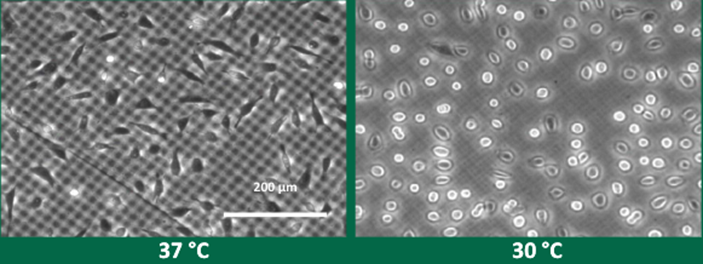Advantages
- Enzyme-free individual cell harvesting: avoids cellular damage, preserving cell viability and surface receptors
- Single-cell resolution: Releases dispersed individual cells rather than large confluent sheets, which is ideal for clonal assays
- Rapid (<1 min), mild stimulus-triggered detachment: triggers detachment via a brief temperature drop which is significantly faster than conventional methods
- Broad platform compatibility: integrates into standard labware via high-throughput photolithography, eliminating the requirement for custom hardware
Summary
Conventional cell-harvesting methods, which require proteolytic enzymes such as trypsin-EDTA or mechanical scraping, can damage fragile membranes, strip away important surface markers, and create workflow bottlenecks. Traditional temperature-responsive coatings release large confluent sheets of cells, making single-cell analysis and clonal expansion difficult. While microtopographic or micropatterned surfaces can influence cell adhesion, they lack the ability to trigger on-demand release.
Our technology uses a photo crosslinked stimuli-responsive polymer, patterned into 5–10 µm protrusions via standard photolithography, to coat any common culture vessel (dishes, flasks, well plates, or slides). At normal culture temperatures, the textured surface supports robust cell adhesion and growth. A brief, gentle temperature drop then triggers the microfeatures to swell, mechanically releasing individual cells into suspension in under a minute. This reconfigurable topography delivers high-viability, damage-free single-cell harvests and can be adapted easily to different vessel formats and adhesion requirements.

10 µm squares spaced 10 µm apart support cell attachment and growth in the collapsed state (left). Placement on ice for 1 minute expands texture features ~20% laterally; rounded cell morphology indicates cell detachment (right).
Desired Partnerships
- License
- Sponsored Research
- Co-Development